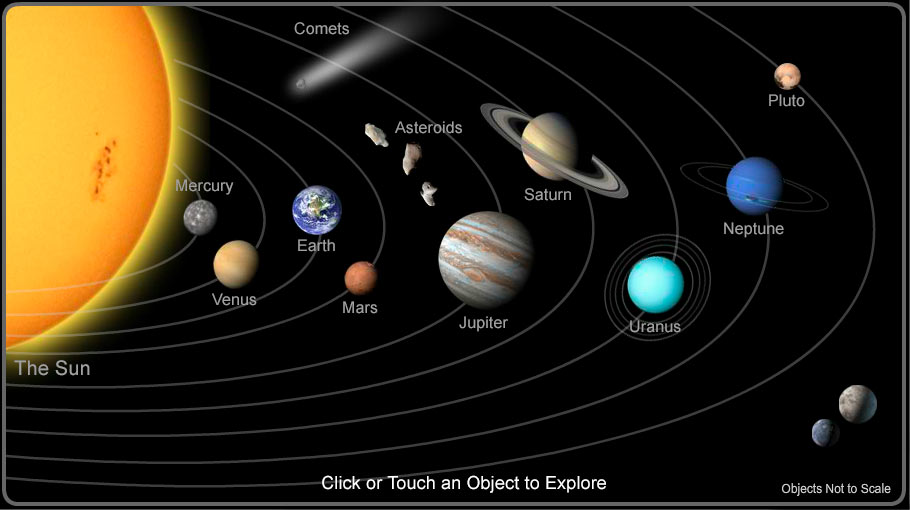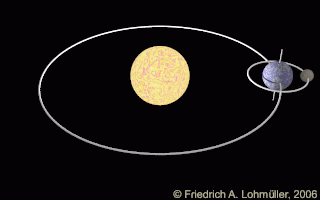2. we have a Kepler belt surrounding the solar system (on a 2D plain)
3. the whole solar system is surrounded by the Oort cloud. a cloud which covers the whole system in a 3D bubble.
4. Pluto was declassified as a planet and is now a dwarf planet
5. between mars and Jupiter, there is an asteroid belt.
6. asteroids orbit the sun just like planets
7. Earth is the only planet in the solar system which can support life
8. Jupiter, Saturn, Uranus and Neptune are all gas giants
9. Mercury, Venus, Earth and Mars are all made of rock 10. The solar system is always moving.

 A solar system refers to a star and all the objects that travel in orbit around it. Our solar system consists of the sun - our star - eight planets and their natural satellites (such as our moon); dwarf planets; asteroids and comets. Our solar system is located in an outward spiral o f the Milky Way galaxy.
A solar system refers to a star and all the objects that travel in orbit around it. Our solar system consists of the sun - our star - eight planets and their natural satellites (such as our moon); dwarf planets; asteroids and comets. Our solar system is located in an outward spiral o f the Milky Way galaxy.- The Earth and other planets revolve around the Sun.
- All the planets in our solar system orbits our Sun. Moons orbit planets. Mercury completes a journey
- The solar system is believed to have been created when a molecular could collapsed under gravity. The mass that collected in the center formed the sun.
- The solar system was formed 4.6 billion years a go when a giant molecular could collapsed .The solar system consist of the sun different size planets and asteroid belts and galaxies.There are 8 planets but Pluto is a dwarf planet. Although it has one moon called Charon.
- The solar system is a family/group of planets meteors, asteroids and much more groups in The solar system
- mercury Venus earth mars Jupiter Saturn Uranus Neptune Pluto also my very eyes may just see under nine
planets The biggest planet in oursolar system is Jupiter. 1321 Earths can fit into Jupiter!!! Jupiter has a storm that has b- Our solar system is made up of the sun and everything that travels around it. This includes eight planets and their natural satellites such as Earth's moon; dwarf planets such as Pluto and Ceres; asteroids; comets and meteoroids






SOLAR SYSTEM 
- The sun is the center of our solar system. It contains almost all of the mass in our solar system and exerts a tremendous gravitational pull on planets and other bodies
- Our solar system formed about 4.6 billion years ago.
- The four planets closest to the Sun - Mercury, Venus, Earth, and Mars - are called the terrestrial planets because they have solid, rocky surfaces.
- Two of the outer planets beyond the orbit of Mars - Jupiter and Saturn - are known as gas giants; the more distant Uranus and Neptune are called ice giants.
- Most of the known dwarf planets exist in an icy zone beyond Neptune called the Kuiper Belt, which is also the point of origin for many comets.
- Many objects in our solar system have atmospheres, including planets, some dwarf planets and even a couple moons.
- Our solar system is located in the Orion Arm of the Milky Way Galaxy. There are most likely billions of other solar systems in our galaxy. And there are billions of galaxies in the universe.
- We measure distances in our solar system by Astronomical Units (AU). One AU is equal to the distance between the sun and the Earth, which is about 150 million km (93 million miles).
- NASA's twin Voyager 1 and Voyager 2 spacecraft are the first spacecraft to explore the outer reaches of our solar system.
een going on for a thousand years. gravity in a solar system seeks equality. Should there have been a ninthplanet it would have been exercised to the nextsolar system.
solar system


